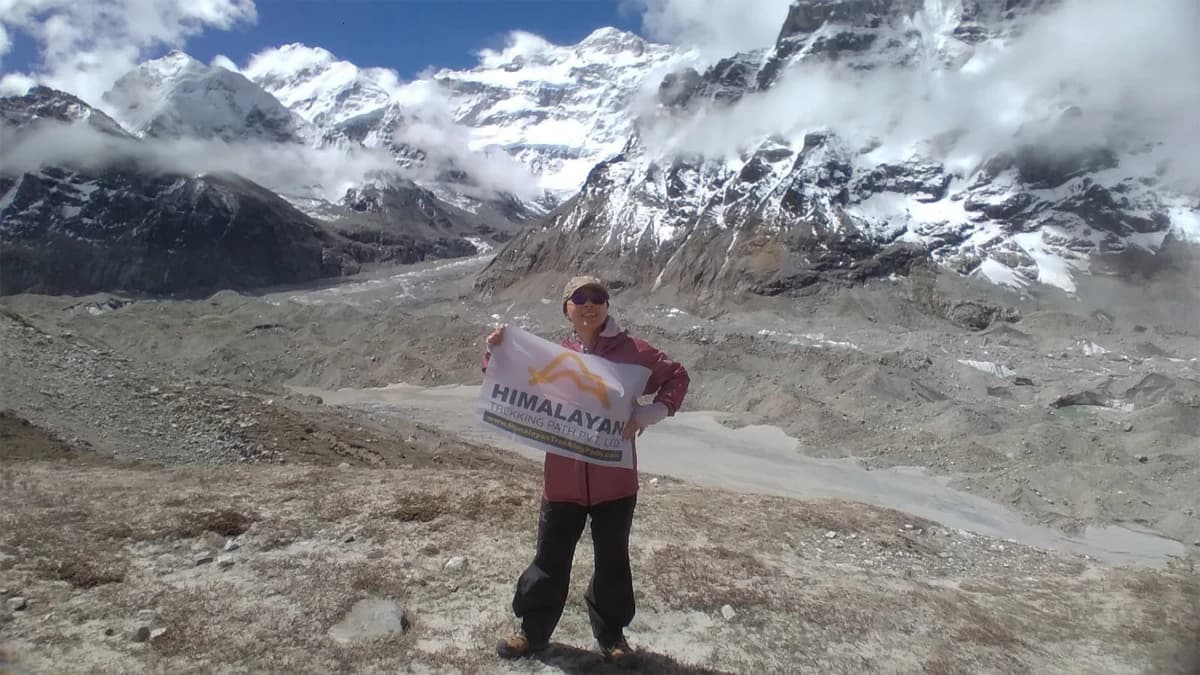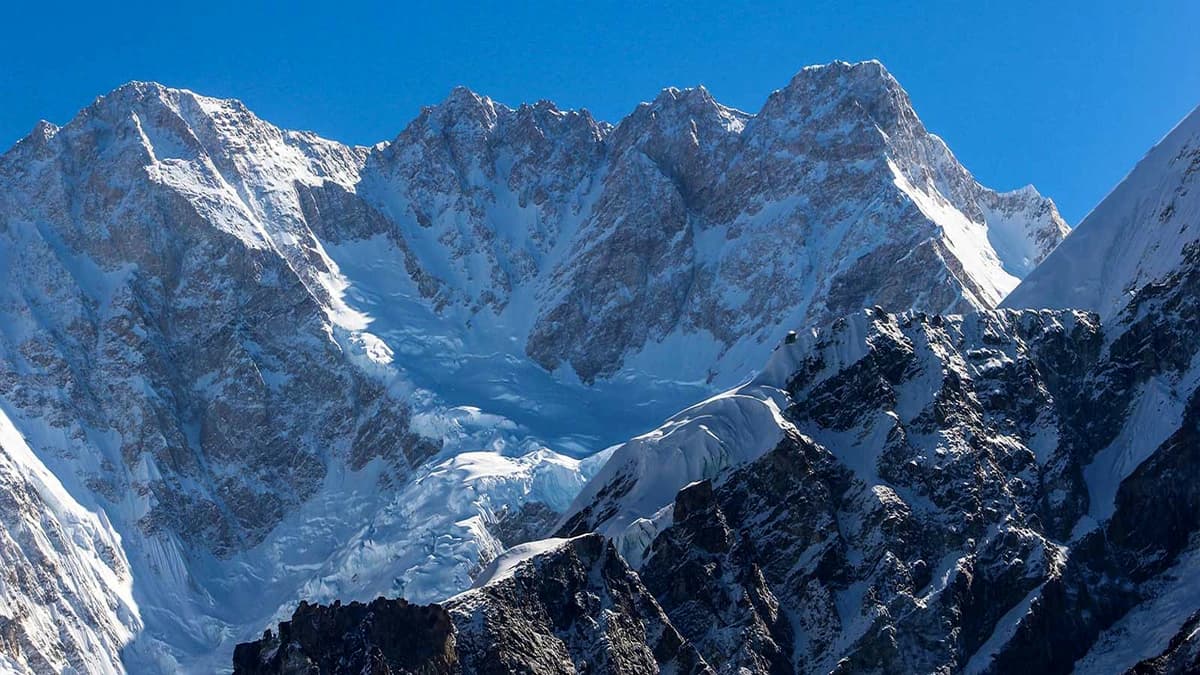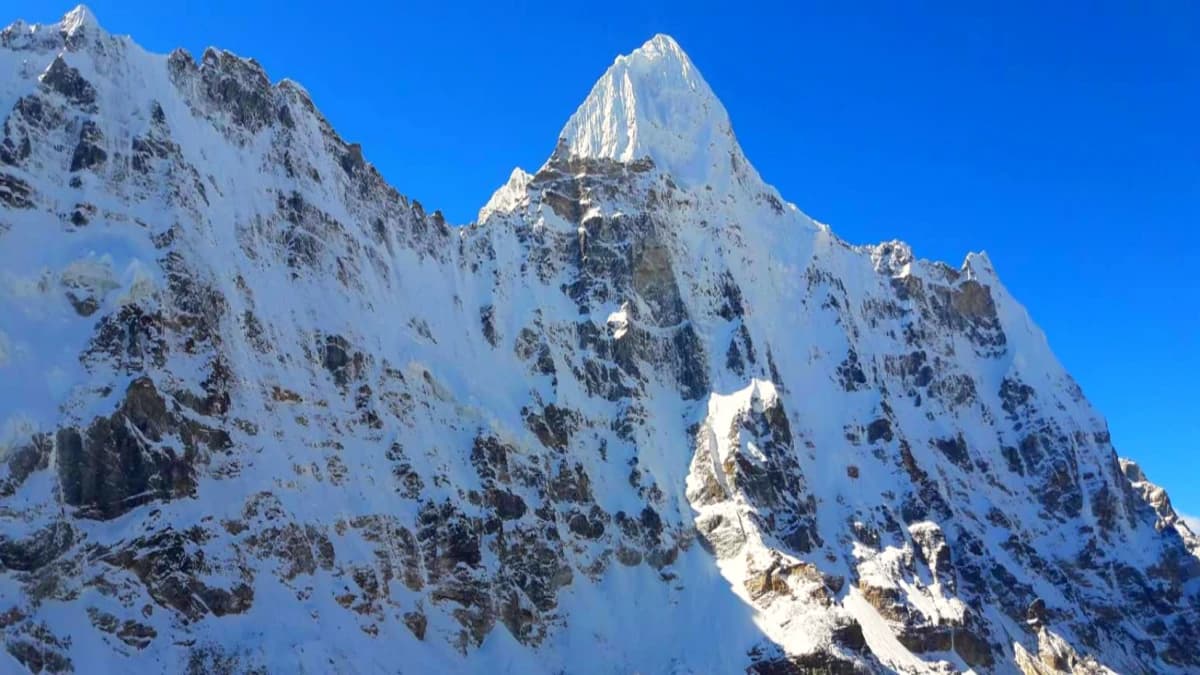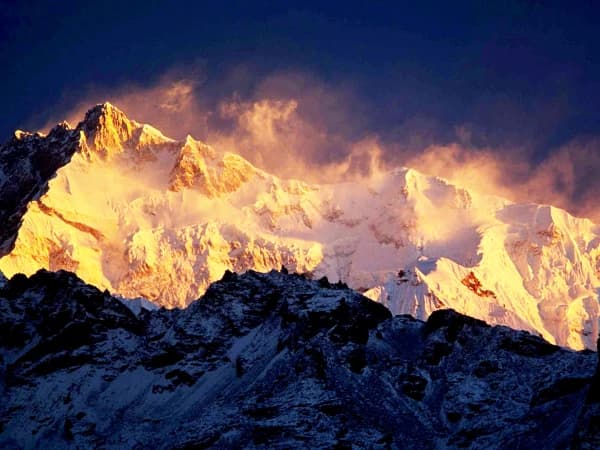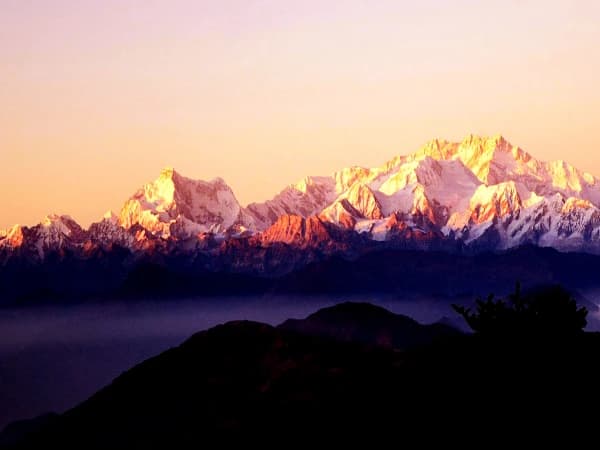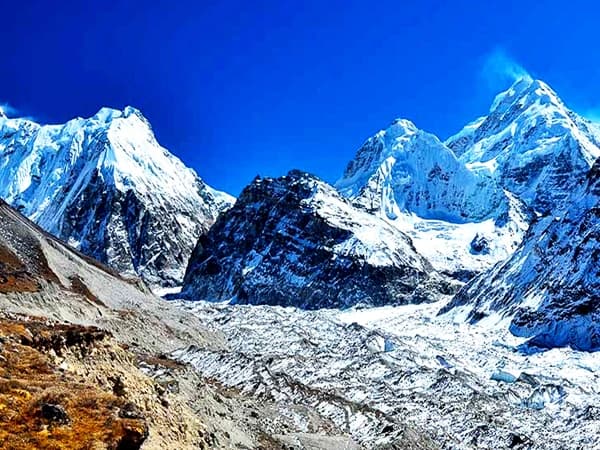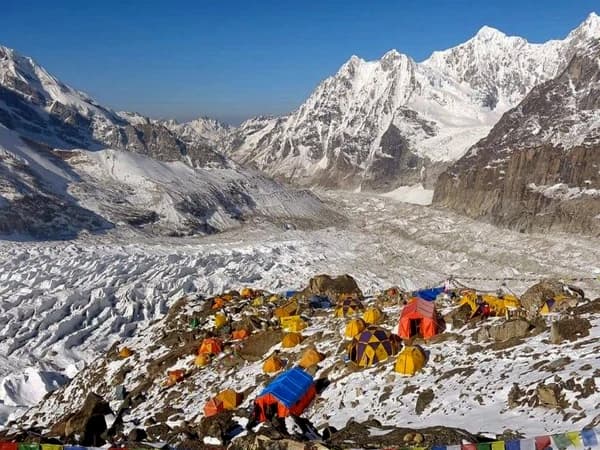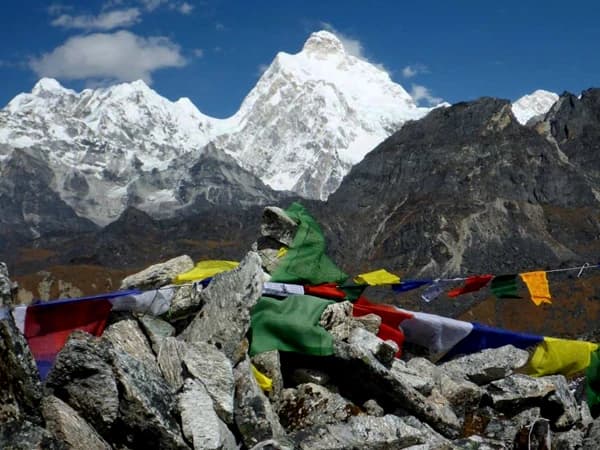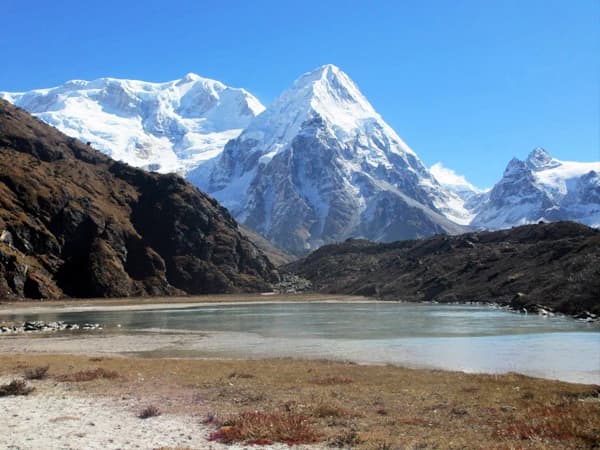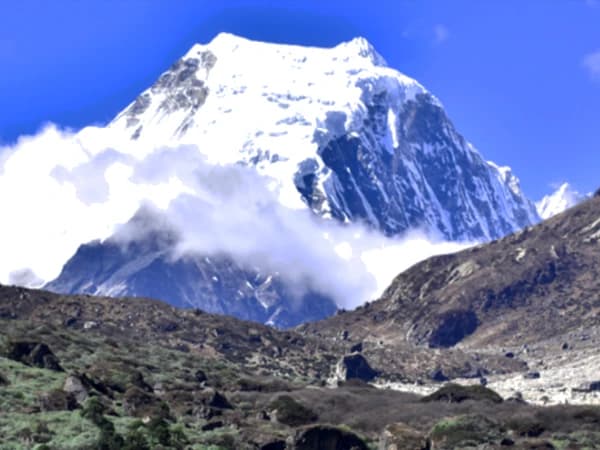Kanchenjunga Circuit Trek:
The Kanchenjunga Circuit Trek presents a unique opportunity for adventure seekers to explore the untamed wilderness of eastern Nepal. This moderately challenging route takes you through the Kanchenjunga Conservation Area project, which shares its borders with Sikkim, India. Along the trek, you will have the chance to visit both the Kanchenjunga North base camp and the Kanchenjunga South base camp, nestled beneath the World's third-highest majestic Mt. Kanchenjunga, towering at an impressive elevation of 8586m (28169.29ft) above sea level. The Kanchenjunga Base Camp Trek is not only a thrilling adventure but also a cultural immersion. It offers a glimpse into the local traditions, lifestyle, and indigenous flora and fauna of the region. As you embark on this journey, you will be surrounded by remote and serene landscapes, adorned with breathtaking views of diverse terrains, lush flora, cascading waterfalls, and captivating wildlife. The Kanchenjunga Circuit Trek, also known as the Kanchenjunga Region Expedition, offers a unique opportunity to explore the entire region. This remarkable journey takes you from the Subtropical zone to the majestic heights of the Himalayas, passing through pristine woodlands adorned with Rhododendron, paks, Pine, and Juniper trees, before reaching the breathtaking tundra. Discover the mesmerizing Pangpema glacier as you trek from Khangbachen, and then make your way back to Ghunsa by crossing the Sele la pass (4480m). Don't miss the chance to visit the south base camp of the world's third-highest peak, Mt. Kanchenjunga (8586m), located at Ramche. Spanning over 23 days, the Kanchenjunga Trek guarantees an unparalleled adventure through untouched and less-explored terrain, creating memories that will last a lifetime.
Highlights:
- The Kanchenjunga Circuit trek spans a distance of 220 km -250km
- Venture off the well-trodden path and immerse yourself in the awe-inspiring landscapes of the planet's most beautiful regions.
- Discover hidden gems of flora and fauna in the picturesque mountain areas along the trail.
- Witness the mesmerizing beauty of the Himalayas as the sun rises and sets from the base camps of Kanchenjunga South and Kanchenjunga North.
- Experience the warmth of local hospitality and savor their delectable cuisine during your stay.
- Embark on an exploration of the eastern part of the country, uncovering its unique charms.
- Delight in the abundant biodiversity and access to medical facilities, making it an ideal destination for nature enthusiasts and health seekers.
- Enhance your journey by exploring the Kanchenjunga conservation areas with the guidance of a knowledgeable local guide.
- Immerse yourself in the rich cultural heritage and traditions of the region.
- Create unforgettable memories as you traverse this remarkable trekking route.
Our journey to the Kanchenjunga Base Camp Trek commences in the historic Kingdom of Kathmandu, where we immerse ourselves in the rich cultural heritage by exploring the UNESCO World Heritage Sites. These sites offer a glimpse into the traditions, arts, and remarkable architecture of the country. However, as per our meticulously planned itinerary, we will then embark on a flight from Kathmandu to Bhadrapur, fully prepared for an extended vacation in the serene and less crowded eastern Himalayas region. This area boasts an isolated and restricted topography, which has been diligently preserved, managed, and monitored by the Kanchenjunga conservation areas since 1997 AD. Our journey will take us through various enchanting locations, including Chiruwa (1270m), Lelep (1750m), Amjilosa (2308m), Gybla (2730m), Ghunsa (3595m), Kambachen (4050m), Lhonak (4780m), Kanchenjunga Base Camp (5143m), Ghunsa (3595m), Selele base camp (4480m), Cheram (3870m), Ramche (4580m), Trorong (2995m), Yamphuding (2080m), Khebang (1915m), Kamdime, Birtamod, Bhadrapur, and finally, we will conclude our adventure by flying back to Kathmandu.
The Kanchenjunga Base Camp Trekking or Kanchenjunga Circuit Trekking in Nepal offers an awe-inspiring adventure that will leave a lasting impression on any trekker. By joining the Local Experts, you can embark on this extraordinary journey. The trails present unexpected challenges, and the high altitude adds another level of difficulty. As a result, only a select few dare to undertake this expedition. However, those who reach the base camp of Kanchenjunga are rewarded with breathtaking views of the majestic Himalayan ranges. Only a privileged few have had the opportunity to witness the grandeur of Kanchenjunga and share their experiences. The Kanchenjunga offers its most breathtaking vistas when traversing the two renowned passes: Selele La Pass and another pass of great altitude. From this vantage point, the awe-inspiring sights of Everest and Makalu are truly praiseworthy. The panoramic arrangement of these majestic mountains, visible from this spot, seems as though their placement has been meticulously orchestrated over countless centuries. It is undeniably captivating. Embarking on a trek to Kanchenjunga can fill your spirit with countless unforeseen wonders. Thus, it is an opportune moment to greet Kanchenjunga.
This trek takes you to the heart of the mighty Kanchenjunga ranges, allowing you to experience the local culture, interact with the Rai and Lumbu people, and witness the region's unique flora and fauna. The Kanchenjunga region is renowned for its medical hubs and is home to rare wildlife such as Snow Leopards, Himalayan Asian Black Bears, and Red Pandas, although spotting them can be quite challenging due to their elusive nature. Additionally, you can expect to encounter common bird species like the Blood Pheasant and Chestnut-breasted Partridge. As you embark on this journey, you will traverse through various climates, ranging from subtropical to the Himalayan tundra, providing you with breathtaking views of the diverse flora and fauna as well as stunning scenery. If you seek a remote and untouched natural and cultural experience, coupled with challenging terrain, the Kanchenjunga Trek is a must-visit destination for your upcoming holiday. Please note that while prior mountaineering experience is not necessary, it is important to be physically fit and adequately prepared for this demanding trail and high elevation. We recommend engaging in cardio exercises such as running, cycling, and hiking to ensure you are in good shape for your planned visit.
The Kanchenjunga Base Camp Trek offers a chance to discover the entire area and reside in the local tea house, where meals (breakfast, lunch, and dinner) are provided throughout the journey. The primary trekking seasons are from September to November and March to May when the sky is clear and the mountain visibility is fantastic. There are three permits required, namely TIMS, restricted, and conservation. To acquire these permits, it is necessary to be part of a trekking agency and have a minimum of two trekkers in a group.
Looking forward to the trek Kanchenjunga Trekking? Then, get in touch with us right now and book this exciting expedition instantly with us!
Kanchenjunga Trekking Difficulty
The Kanchenjunga Trek is renowned for being one of the most demanding treks in Nepal. It entails navigating through treacherous landmarks in the region, making it a challenging endeavor. The majority of the trek takes place in the rural and remote areas of eastern Nepal, which adds to the strenuous nature of the journey. However, despite these difficulties, you will be rewarded with breathtaking views of the stunning landscape, the majestic Kanchenjunga, Everest, and Makalu mountains, as well as the untouched nature and rich culture of the western part of the country. The trail spans 23 days, during which you will need to cover a distance of 10 to 15 km each day along narrow rustic paths. Accommodation will be provided in basic tea houses along the way, and you will encounter high passes such as Selele la Pass (4480m), Nango Laptse Pass (4750m), and Base Camp (5143m). Physically, this trek is demanding, but it is also an incredibly captivating, thrilling, and rewarding journey through the untouched region of Nepal. To successfully conquer the Kanchenjunga Trek, it is essential to adequately prepare beforehand. We recommend incorporating walking, cycling, and hiking into your routine. While prior mountaineering experience is beneficial, individuals who are fit and healthy can also embark on this trek for the first time.
Kanchenjunga Trekking Packing List
Himalayan Trekking Path offers valuable insights on how to adequately prepare for the exhilarating and fulfilling Kanchenjunga Trek. This 23-day-long adventure requires thorough preparation to ensure a memorable holiday experience along the newly established tea house trek to Kanchenjunga Circuit Trek. The packing list serves as a crucial starting point for this remarkable journey.
- Sleeping bag and down jacket suitable for temperatures around -20 degrees Celsius.
- Waterproof hiking boots for sturdy and reliable footwear.
- Light sandals or plimsolls for wearing in the lodge
- Towels, shampoo, and toiletries for personal hygiene.
- Trekking poles and headlamp for assistance during the trek.
- Camel bag or water bottle to stay hydrated throughout the journey.
- Iodine water purification tablets or sterilizer pens to ensure safe drinking water.
- Several large plastic bags, one for storing smelly clothes and another for keeping items dry.
- Windbreaker jacket and fleece coat to protect against cold and windy conditions
- Warm woolen beanie, sun hat, and multiple pairs of socks for adequate head and foot protection.
- Long and short trekking pants in various quantities for flexibility in different weather conditions.
- Thin thermal under trousers for added warmth.
- Several quick-dry t-shirts, gloves, sunglasses, and sun cream for sun protection.
- Duffel bag for your equipment, which will be carried by a porter.
- A day bag with a capacity of 30 liters to carry your valuable belongings.
Kanchenjunga Trekking Permits Fees and Documants
To embark on the unspoiled Kanchenjunga Trail, you will need three specific permits. These permits include the Restricted Areas Permit (RAP), Kanchenjunga Conservation Area Permit (KCAP), and Trekkers Information Management System Card (TIMS), all of which must be obtained in Kathmandu before commencing the trek. The permit application process entails submitting a copy of your passport, a passport-sized photo, being part of a group with at least 2 trekkers, and possessing a special permit visa. If you are trekking solo, don't fret as we can assist you in obtaining the necessary permits by paying an additional fee. The costs for these permits are outlined below.
- Restricted Permits fees are $ 20 per person/week (for the first 4 weeks)
- Kanchenjunga conservation fees are $30 per/ person
- TIMS (Trekkers information managment system) fees are $20 per person.
- To obtain the restricted permits, required an original passport, 4 pieces of passport-size photos
How can one get ready to combat Acute Mountain Sickness?
- Ensure adequate hydration by consuming approximately 3 to 4 liters of water daily.
- Take leisurely walks and remember to take regular breaks every 30 minutes during your trek
- It is important to adhere to the instructions provided by your guide and follow the planned itinerary.
- Avoid rushing and unnecessary worry during your trip.
- Consume sufficient food to replenish your stamina levels.
- Take pleasure in the beauty of nature and the surrounding scenery.
- Refraining from consuming alcohol and smoking at altitudes above 4000m is crucial for maintaining good health and preventing altitude sickness.
Kanchenjunga Trekking Cost for 2025-2026
The pricing for the Kanchenjunga Trekking is determined based on the inclusions and exclusions of services. Additionally, it is influenced by the policies and strategies of the company in promoting the Kanchenjunga trek. At Himalayan Trekking Path Company, we are dedicated to promoting the Kanchenjunga Trek and providing our esteemed clients with an unbeatable original cost. The cost for the Kanchenjunga trek ranges from 1800 USD per person in a group to USD2500 for solo trekkers, allowing you to enjoy a private tour experience with us. This cost includes permits, food, accommodation, a guide, a porter, transportation, domestic flights, and more. Please find below the breakdown of our promoted Kanchenjunga trek cost based on the group size.
- The Cost of the Kanchenjunga Trekking is USD 2500 for a solo trekker
- The Cost of the Kanchenjunga Trekking is USD 1800 P/P if you are traveling in a group of 2-6 Pax
- The Cost of the Kanchenjunga Trekking is USD 1650 P/P if you are traveling in a group of 7-10 Pax

